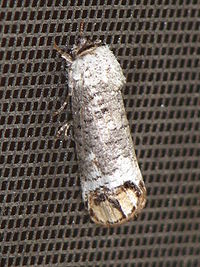Cossidae
| Cossidae | |
|---|---|
 |
|
| Cossula magnifica (Cossulinae) | |
| Scientific classification | |
| Kingdom: | Animalia |
| Phylum: | Arthropoda |
| Class: | Insecta |
| Order: | Lepidoptera |
| Superfamily: | Cossoidea |
| Family: |
Cossidae Leach, 1815 |
The Cossidae, the cossid millers or carpenter millers, make up a family of mostly large miller moths. This family contains over 110 genera with almost 700 known species, and many more species await description. Carpenter millers are nocturnal Lepidoptera found worldwide, except the Southeast Asian subfamily Ratardinae, which is mostly active during the day.
This family includes many species with large caterpillars and moths with a wingspan from 9–24 cm (3 1⁄2–9 1⁄2 in). These moths are mostly grey in color; some have long, narrow wings and resemble hawkmoths (Sphingidae) which are more advanced Macrolepidoptera, however. Many are twig, bark, or leaf mimics, and Cossidae often have some sort of large marking at the tip of the forewing uppersides, conspicuous in flight, but resembling a broken-off twig when the animals are resting.
Caterpillars are smooth with a few hairs. Most cossid caterpillars are tree borers, in some species taking up to three years to mature. The caterpillars pupate within their tunnels; they often have an unpleasant smell, hence another colloquial name is goat moths.
The family includes the carpenterworm (Prionoxystus robiniae) and the goat moth (Cossus cossus) which have gained notoriety as pests. However, the large caterpillars of species that do not smell badly are often edible. Witchetty grubs – among the outback's most famous bush tucker – are most commonly the caterpillars of Endoxyla leucomochla, one of the more than 80 cossid species in Australia. In Chile, the sweet-smelling caterpillars of the Chilean moth (Chilecomadia moorei) are harvested in quantity and internationally traded as butterworms, for use as pet food and fishing bait.
...
Wikipedia
